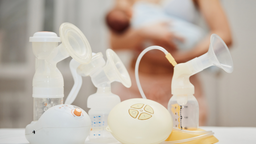We’re pleased to share a guest post from Wendy Armbruster Bell is the Founder & Creative Director of Snugabell Mom & Baby Gear, creators of the PTPA Award-Winning PumpEase hands-free pumping bras.
As the end of maternity leave fast approaches, nursing mothers have a number of choices to maintain their breastfeeding relationships with their babies. This holds true no matter how long your maternity leave will be or if you have chosen to return to work early of your own accord.
Childcare Can Be Your First Resource
Start looking for childcare while you are still pregnant, as it is usually the biggest obstacle. Look for a private provider who is close to your office and try to schedule going to your baby to nurse the first week or two as a transition for both you and the baby. Some providers might even be willing to bring your baby to you at work for feedings. The sustained contact will be good for both of you emotionally and will facilitate your letdown as well as help to maintain your milk supply as you both adjust to the new routine.
Returning to Work
Remember to discuss your breastfeeding and/or pumping schedule with your employer prior to your return to work so that there are no surprises for either of you. It is also a good idea to return to work on a Wednesday or Thursday so you have a short first week. Finally, plan a dry run of your morning routine, including the drive to work, before tackling the real McCoy. This will do wonders for your stress level on that first day of leaving baby.
Following is a typical schedule that can be adapted to suit (based on a baby who is 3-6 months old):
6:00 am: Wake up, get ready for work and eat a healthy breakfast.
7:00 am: Wake and nurse your baby.*
10:00 am: Pumping break (or nurse baby).
12:00-12:30 pm: Eat a nutritious lunch and pump.
2:30 pm: Pumping break (or nurse baby).
5:00 pm: Leave work for the day.
5:30 pm: Pick up baby and nurse.
Try this schedule (or one that is similar based on your work schedule) a couple of days before returning to work and make sure your supply doesn’t suffer. Make adjustments if necessary.

Tips for Pumping at Work
If you will be pumping at work even once per day, you may want to invest in a hands-free pumping bra so that you can still answer emails, eat lunch or take phone calls while pumping.
Make sure you have a comfortable chair to sit in, a footrest to raise your knees to parallel while sitting (so that you don’t hunch over) and if you have problems with letdown, a picture of your baby or an article of clothing that smells like him/her.
Remember that you should wait 4 weeks to introduce a bottle to your newborn to reduce the chance of nipple confusion.
If you don’t have an office with a lock on the door, then you will also need to find a private room that you can use for nursing and/or pumping – and try to avoid the restroom!
Why Lactation Rooms Rock
Approach your employer to set-up a lactation room. You can pitch him or her on the benefits of having a breastfeeding mother on staff. Never mind the extensive long-term health benefits for BOTH mom and baby, in the short-term, research shows that:
- breastfed babies are sick less often and when they do get sick, then aren’t as sick
- breastfed babies are less likely to have ear infections, colic, diarrhea and other childhood illnesses
- babies who are breastfed are 10 times less likely to be hospitalized during the first year
- nursing mothers have a lower incidence of postpartum hemorrhage
- nursing mothers often stay amenorrheic for several months. The amount of iron a mother’s body uses in milk production is much less than the amount she would lose from menstrual bleeding. The net effect is a decreased risk of iron-deficiency anemia in the nursing mother as compared with her formula-feeding counterpart. The longer the mother nurses and keeps her periods at bay, the stronger this effect.1
Therefore, because you and your baby will be sick less frequently, your employer will benefit from reduced sick days and in turn, increased productivity from you!
After Solids Schedule
After your baby starts solids (usually around six months of age), he/she will be taking less breast milk. You may choose to pump during the day and breastfeed first thing in the morning and at bedtime as well as on the weekend. Your baby could take one bottle of expressed breast milk in the afternoon (2:30-3:00 pm) and you will still successfully maintain your supply. These types of arrangements along with an open mind, flexibility and support will help you reach your personal breastfeeding goals.

You Need Support!
Speaking of support, a lack thereof is one of the top reasons for the extreme decline in breastfeeding rates after moms leave the hospital. The best thing you can do is to keep the following in mind:
- breastfeeding is not “instinctual”, both mom and baby need to learn how to do it
- if you are having difficulties, ASK FOR HELP from your Public Health Nurse (Canadians only), Doctor, Midwife, Doula, Lactation Consultant, La Leche League Leader, friend or family member
- there appears to be a learning curve for the first 6-7 weeks postpartum - if you can persevere until then, you are usually home-free
- resist the temptation to give your baby formula – as little as one feed per day can cause your supply to diminish – keep a small stash of breast milk in the freezer instead
Can You Hire a Nanny?
Many people are under the impression that a live-in nanny is out of reach financially; however, this choice could be quite affordable compared to group daycare, especially if you have more than one child.
If you compare the cost of group daycare (up to $1500 per month, per child) to a nanny (about $1100 per month after deducting room and board) while considering that you also have the option of arranging a “nanny share” with a friend, family member or co-worker, that the price of the nanny remains the same no matter how many children you have, as well as the fact that they often help around the house including dinner preparations and light cleaning, then a live-in nanny isn’t as out of reach as you may think. You simply need to crunch some numbers and be resourceful.
You Can Do It!
As with many seemingly insurmountable challenges in life, one day you will look back on your choice to maintain breastfeeding after your return to work and say, “It was a bit of a challenge initially, but soon it was just another routine. I did it and it was absolutely worth it!”
Wendy Armbruster Bell is the Founder & Creative Director of Snugabell Mom & Baby Gear, creators of the PTPA Award-Winning PumpEase hands-free pumping bras. When she is not helping thousands of breastfeeding moms around the world pump hands-free and in style, she and her husband Mike are busy raising their two young daughters in beautiful British Columbia, Canada. She has been featured in Baby Talk, Pregnancy & Newborn and TIME magazines as well as on Dragons’ Den, Cool Mom Picks, Parents TV, Breakfast Television and Celebrity Baby Scoop. Wendy was named a Top Mompreneur for 2009 by The Mompreneur Magazine and was a top finalist in Small Business BC’s Successful You Awards in the Business Growth category in 2010. For more information, please visit www.PumpEase.com. Wendy can be contacted at wendy@snugabell.com or toll-free at 1.866.963.SNUG (7684).




